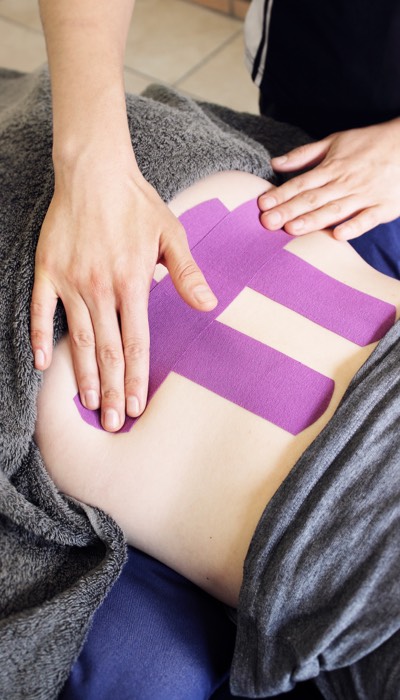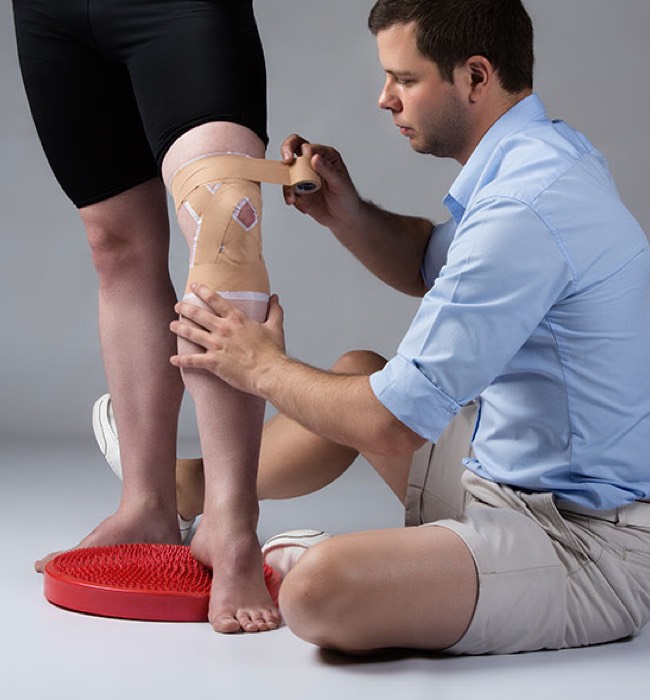Strapping
Physiotherapists use taping to help their patients for a particular condition or injury. Strapping is used to redirect forces in your body, to relieve pressure or strain off the painful area. Each type of physio strapping has its own function and acts on the tissue in various ways.
The main purpose of strapping any part of the body is to prevent injury, or to provide support for an existing injury. Taping a joint makes this possible as it restricts movement, while providing support for tendons, ligaments and muscles.
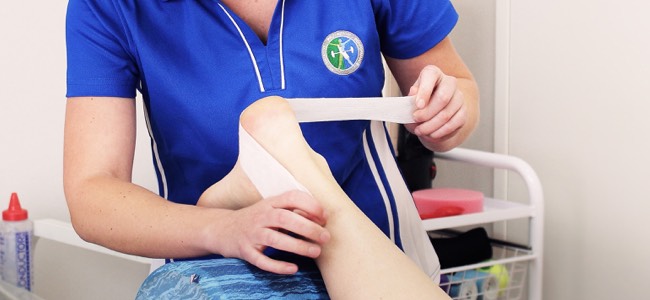
Physio Strapping & Taping
Physio taping is the process of applying tape directly to the skin in order to maintain a stable position of bones and muscles during activity. It is a procedure that uses tape, attached to the skin, to physically keep in place muscles or bones in a certain position. This reduces pain & aids recovery. Physio taping is usually used to help recover from overuse and other injuries.
The aim of physiotherapist taping are to restrict the motion of an injured joint, compress soft tissues to reduce swelling, support anatomical structures involved in the injury, serve as a splint or secure a splint, secure dressing or bandages, protect the injured joint from re-injury, and protect the injured part while the injured part is in the healing process.
Types of Physio strapping:
Sport strapping
Elastic cream color strapping. This tape stretches in length when you pull it apart.
Uses: Compression over a wound, or protecting a muscle by compressing the muscle to the bone, but allowing normal movement.
Rigid strapping
Brown or White strapping. This tape doesn’t stretch when pulled apart.
Uses: Immobilization, joints kept in position.
Dynamic strapping
Looks like a tattoo, usually flesh color with tattoos on. This tape can stretch when pulled apart and also in its length.
Uses: Assist with a specific movement.
Kinesiology Tape strapping
Comes in different colors like pink, blue, black, white. This tape can stretch when pulled apart but has very different characteristics opposed to other types of taping.
The tape itself is an elastic woven tape that comes in a variety of widths, colours and types, and is cut into different shapes. It may look like conventional athletic tape but it is fundamentally different in that it has a specific elasticity that plays a role in its effectiveness. There are different ways of applying the tape, depending on the aim of the strapping.
It is thin, like skin and is applied by professionals trained specifically for the different applications. It is placed on top of the skin strategically, and is effective for 3 to 5 days before it needs to be replaced. You can shower or swim with it. It does not contain any medication, instead its effectiveness is due to the design of the tape itself and its application by a trained physiotherapist.
Uses: Help improve performance of muscles by activating certain movement patterns.
Strapping is not the same as bandages. Bandages are used for compression over a wound.
Why Physio strapping?
- Prevent injury
- Protect an injury from getting worse
- Stop certain movements that cause pain
- Protect joints
- Activate muscles
- Improve muscle power
- Relive pain
- Improve healing
- Helps the joints move in the right direction
- Improve lymphatic drainage (waste product removal)
While physio taping can be quite useful in preventing, and rehabilitating injuries, it is important to realize that it is not a substitute for complete rehabilitation. Proper tissue healing, range of motion and strength deficits, as well as body awareness and balance issues must also be addressed. Therefore taping is a useful tool for many people in conjunction with their rehabilitation.
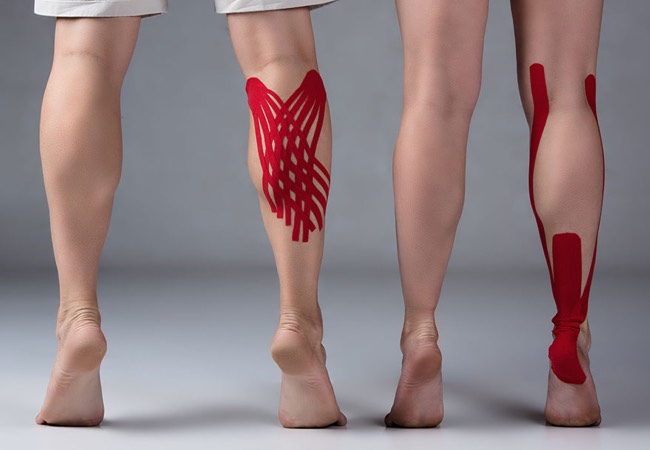
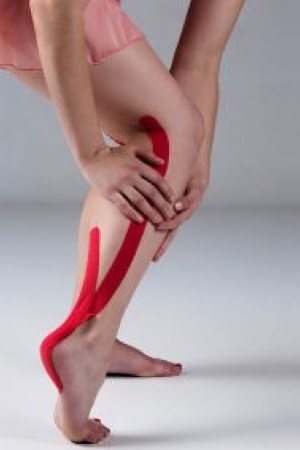
Sports Strapping
Sport strapping is appropriate for many types of common sports injuries. They can be of benefit to muscle strains or tears, bruising, ligament sprains or tears, broken bones, and dislocations and subluxations. Immediately remove the strapping after your sporting activity.
The sports tape comes off more easily, and the joint or muscle should be given back its own control so it doesn’t become reliant on the strapping, and blood flow can return to normal.
There are correct ways to strap each joint of the body. Seek advice from a Sports Physio to learn the correct technique. Incorrect strapping can actually harm the joint, be very uncomfortable, and limit your ability to perform. It is important to consult with your physiotherapist, who can work with you to ensure your injury heals in the shortest possible time, while keeping you performing to the best of your ability.
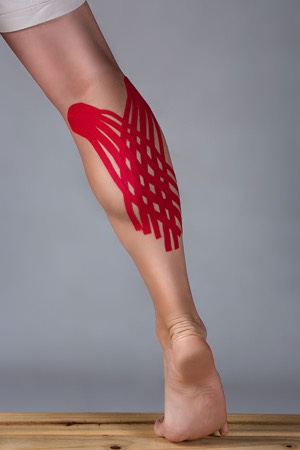
Why Physiotherapist use strapping
Physio taping has many roles such as to support the ligaments and capsules of unstable joints by limiting excessive or abnormal anatomical movement. Taping also enhances proprioceptive feedback from the limb or joint. Taping can support injuries at the muscle-tendon units by compressing and limiting movement.
Strapped Most commonly
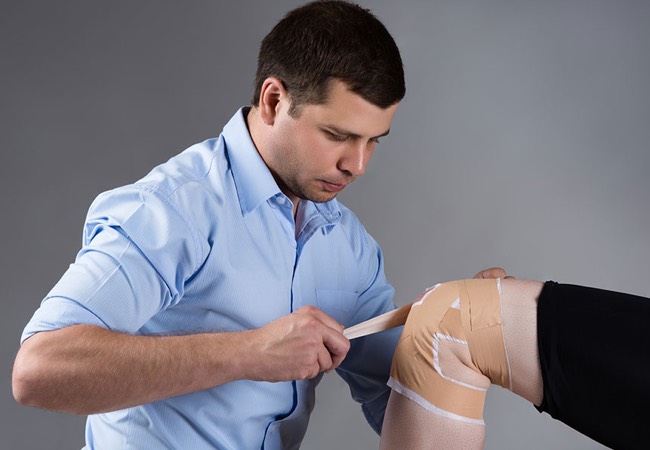
How will I know if I’m allergic to the tape?
When the skin around the taped area becomes red, itchy, burns or blisters you may be allergic to the tape.
Follow these steps:
- If you develop an allergic skin reaction you should remove the tape immediately. The skin should be washed and patted dry.
- Do not reapply any tape again and ensure that you inform your physiotherapist.
- If at any time you feel that the tape is aggravating your injury then you should remove it.
How do I remove the tape?
- Do not tear the tape off quickly as this may damage your skin and lead to further irritation. Turn around the edges of the tape, and fold it back onto itself, hold your skin with one hand as you gently separate the strapping from your skin.
- Always remove the tape slowly and carefully easing it away from the skin.
- The tape’s glue may be softened in water beforehand to aid its removal.
- Note that warm water is counter productive due to the glue becoming stickier, like Prestick being heated.
How do I know if the tape is too tight?
- The tape is too tight if the skin below the tape looses its normal color.
- Its quite rare that your skin turns blue, because the pressure in your arteries (which sends the blood from your heart) is much higher than your venous system (the blood being sent back). Hence you will observe swelling in the tissue further away from your heart, therefore the strapping restricts the blood flowing back to your heart.
- A “tiredness” or weakness in the area below the strapped area is usually the first sign.
- You may also experience pins & needles or numbness.


